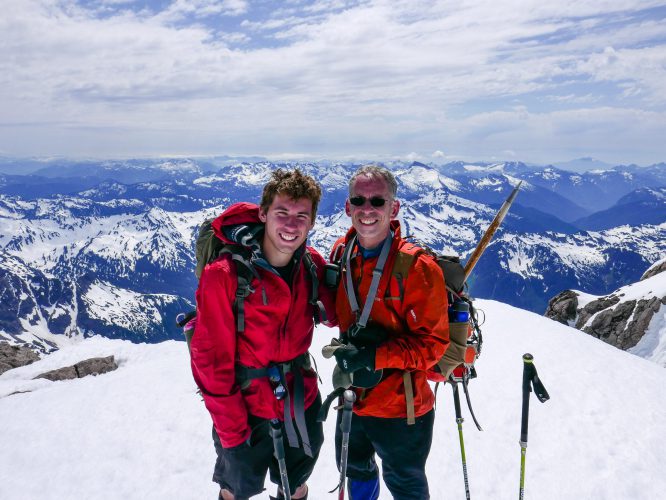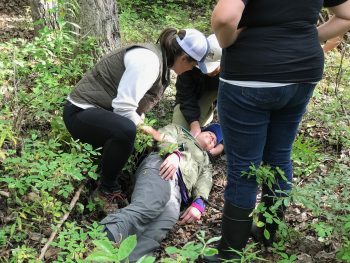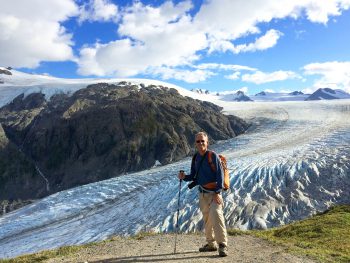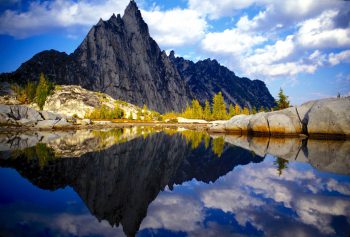
Like many Pacific Northwest residents, Dr. Douglas Diekema is an avid hiker, camper, climber and skier. His favorite trails near Seattle include Snow Lake, Mount Dickerman, Lake Serene, Perry Creek and Goat Lake.
But Diekema, an emergency medicine physician and director of education in the Treuman Katz Center for Pediatric Bioethics at Seattle Children’s, not only enjoys the great outdoors – he helps people learn how to stay safe while in the wilderness. His emergency medicine expertise, appreciation for the outdoors and interest in environmental exposure-related conditions intersect in his passion for wilderness safety.
Diekema’s experience with helping people in the wilderness spans from treating minor blisters and cuts, to managing people with hypothermia or a sprained ankle. Diekema teaches an annual course on wilderness medicine for the hospital’s Alaska Track Residency. For the past 25 years, he has also taught an annual wilderness medicine course to Seattle Children’s residents, which includes hands-on training in the Alpine Lakes. Residents learn how to rescue and treat an injured individual, transport a person who cannot walk, keep people safe and warm, and avoid getting lost in the woods.
“It’s important to learn how to improvise in the wilderness,” Diekema said. “I’ve heard from previous trainees that the skills they learned are invaluable when they’re on an airplane and a doctor is needed, when they’re out with a Boy Scout troop, or when they’re traveling in Africa and someone has a seizure – all situations where they don’t have tools they would have in an emergency room or clinic.”
Beyond training medical professionals, Diekema said it’s also important that families understand how to stay safe in the wilderness and avoid potential hazards.
“In the Pacific Northwest, I see people on trails who are unprepared and unfamiliar with the potential risks,” Diekema said. “Making parents aware of those risks and how to be prepared when hitting the trails with their kids is vital to prevent accidents.”
Understanding risks of the wilderness

Diekema said the most typical injuries associated with outdoor recreation include snake or spider bites, minor cuts and bruises, heat exhaustion, frostbite, injuries from falls, and drowning. The most common risks in the wilderness include snow, getting lost, running out of necessary supplies, and bodies of water.
“In the shoulder season, there is often snow on the mountains,” Diekema said. “Snow often starts to melt from the bottom. If people are not careful, they could be walking on a layer of snow that’s only 1 or 2 inches thick with 2-3 feet of air between it and the rocks underneath. If the snow gives way, they could drop several feet, causing injury or worse. Now you have a medical emergency.”
Diekema also cautions against parents taking children on hikes without bringing food, water or extra clothes.
“The assumption people make is that nothing bad will happen, but sometimes that’s not the case,” he said. For example, if a hiker slips and breaks an ankle, and there’s no one else around, they could get cold, dehydrated and have no way of tending to their injury.”
In 2005, Diekema studied how kids in Western Washington died while recreating in wilderness environments. He examined the topic due to his interest in preventing fatal wilderness injuries. Over a 10-year period, there were 40 deaths. More than half were water related. Those who died were primarily adolescents who participated in dangerous activities with friends, like cliff jumping. The other at-risk group was toddlers. Most toddlers drowned with parents nearby.
“They’re devastating stories, but there are lessons there too,” Diekema said.
Parents may not recognize how dangerous wilderness water can be, especially fast flowing rivers. It’s easier to rescue a drowning child from a pool than a flowing river or a murky lake, Diekema said. In some cases, children were swept away by a river or fell into a lake without wearing a life jacket. Cold water might lead to an initial shock experience, preventing people from responding appropriately. Even if parents see the event occur, there may be little they can do.
“Close and constant adult supervision, and ensuring children are wearing a life jacket at all times, are key for water safety,” said Diekema.
The 10 essentials to bring
 “Everyone should always carry some form of the 10 essentials,” Diekema said.
“Everyone should always carry some form of the 10 essentials,” Diekema said.
Nearly all “10 essential” lists include food, water, a first aid kit, a knife, warm clothes, rain gear, a compass, and a map. The ability to read a map and compass is vital if people are at any risk of going off trail, said Diekema.
Though it can’t always be relied on since some areas lack cell phone service, a fully charged cell phone is useful as a map, communication device and a way to prevent getting lost, especially if the user downloads topographic maps. Diekema also uses his phone to take photos of confusing intersections or sketchy terrains to use as reference points when finding his way back.
Everyday items have numerous uses in a pinch, Diekema said. Duct tape can secure items, close wounds, repair objects and even secure a splint for a sprained ankle. Garbage bags are one of Diekema’s favorite survival items. They are light and can be used for collecting water, as a rain jacket, or as an improvised sleeping bag if stuffed with leaves for insulation.
Hikers can prepare for potential cold or wet conditions by bringing additional clothing, such as rain gear and warmer layers of clothing.
“Extra clothing for each person is really important, and that’s often forgotten during hot summer days,” Diekema said.
Diekema pointed to the Boy Scout troop members who were recently rescued from Mount Baker and treated for hypothermia.
“They got caught in conditions they weren’t expecting,” Diekema said. “If you’re going to summit Mount Baker, you have to be prepared to spend the night on top.”
Hiking and camping with kids

While hiking with children, Diekema recommends bringing plenty of kid-friendly snacks and recognizing that kids are more at risk for heat and cold injury. Parents should make sure children are dressed appropriately for the conditions and their level of activity, and that they are wearing sun protection and insect repellant that is safe for children. Even if a parent is warm, the child might be cold if they are being carried.
When planning a hike, a helpful general rule to remember is that a child can hike about as many miles as their age in years, Diekema said.
“One thing that makes parents miserable is having unrealistic expectations,” he said. “A lot of hardcore hikers need to reset their goals for a hike when they have a 3-year-old.”
While camping, “parents should childproof their campsite the same way they childproof their homes,” Diekema said. “When we camped with younger kids, we would survey the entire area to identify what might be a hazard for a small child. We tried to devise a way of reducing any risks.”
This might mean finding a way to keep children away from nearby water, protecting children from a burning fires and removing dangerous objects lying out, such as axes.
“One strategy we used was putting bear bells on our kids’ shoes,” Diekema said. “While parents are setting up a tent or cooking dinner, a toddler can disappear in seconds. Bear bells would alert us that our daughter or son was taking off on an adventure, and we could retrieve them before they got too far away. We also outfitted our kids’ jackets or backpacks with a whistle to use if they got lost.”
In the Pacific Northwest, Diekema recommends family-friendly hikes such as Lake 22, the trails at Sunrise on Mount Rainier and Grove of the Patriarchs at Mount Rainier.
“There are lots of kid-friendly trails in Mount Rainier where the adults can enjoy spectacular views,” Diekema said.
When it comes to concern around dangerous animal encounters, Diekema said cougar and bear attacks are rare in the Northwest. But if someone does have an encounter, they should never approach animals, run from them, or turn their backs on the animal. Instead, give animals space, let them leave and back away from the situation slowly. Young children should also never be allowed out of sight of adults while hiking.
“If wild animals feel threatened, they will defend themselves, but most cougars have no interest in humans,” Diekema said. “It’s not something people should lose sleep about. They should just be smart about it.”
Overall, Diekema said he doesn’t want people to think the wilderness is a dangerous place.
“I don’t think it’s any more dangerous than the city, but we’re more familiar with the risks in the city,” Diekema said. “Recreating in the wilderness is just as safe as anything else we do with kids, as long as you recognize that there are different risks and you need to appreciate and respect what they are.”
Diekema emphasized that when it comes to exploring the outdoors with children, the benefits outweigh the risks.
“Hiking is a wonderful activity for kids,” Diekema said. “They also hopefully gain an appreciation for how beautiful the landscape is and develop a love of the outdoors.”
Resources
- Where to Hike as a Family (Washington Trails Association)
- Keeping Mosquitoes Away: Insect Repellent and Children
- Begin a Lifetime of Sun Safety Early in Childhood

